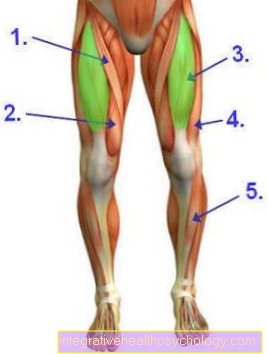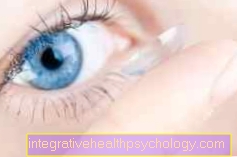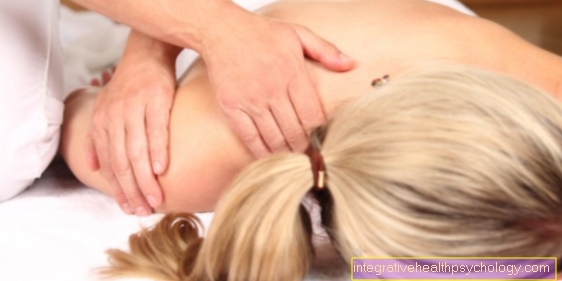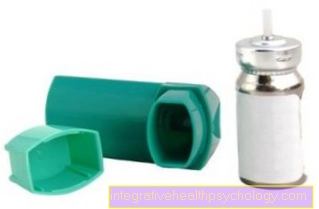Watery eyes
introduction
The eye is covered with a film of tears. This covers the eye like a thin film and ensures that it is protected and supplied with nutrients. When there is an increased production of tear fluid it comes to 'tears' or watery eyes, this phenomenon is also called epiphora in medical terminology.

causes
There are various possible causes of watery eyes. Often there are watery eyes in the context of allergies, for example to pollen or grass. These symptoms usually occur seasonally.
An infection of the eye can also be a reason, mainly viruses or bacteria, and occasionally fungi as triggers.
Environmental influences such as wind, cigarette smoke or exhaust gases can also lead to increased tear secretion. If the ambient air is very dry, the eye can dry out. As a counter-mechanism, the body then produces more tear fluid, which can then lead to the symptoms of a watery eye.
Foreign bodies in the eye are also a possible cause. If these are small splinters, such as those that can arise during sawing work, these must be professionally removed by a doctor.
Contact lens wearers can also suffer from watery eyes, especially if they are worn for a long time or if they are carelessly cleaned.
In the context of underlying diseases such as diabetes in specialist circles also called diabtes mellitus, increased tearing of the eyes can occur.
A malpositioned lid, in which the lid points inwards or outwards, can also lead to watery secretion from the eye.
In addition, general changes to the eye or the tear system can lead to increased tear flow, including, for example, the obstruction of the tear ducts or a dysfunctional lacrimal gland. Such changes can be caused by changes in the hormonal balance, which are particularly evident with the onset of menopause or with aging. Occasionally, certain medications can cause watery eyes as a side effect.
Read more on the topic: Lacrimal inflammation
cold
In addition to the familiar symptoms of coughing, sore throat and runny nose, a cold can also lead to watery eyes. The runny nose or nose is primarily responsible for this. During puffing, the nasal mucous membrane swells, which ensures that the tear fluid, which normally drains through certain channels in the nose, is blocked. The tear fluid produced is then released into the eye in the form of tears. Classically, the watery eyes usually disappear when the other cold symptoms subside.
Find out more about the following: Symptoms of a cold
allergy
A classic allergic reaction to environmental substances such as pollen, grass or animal hair is often associated with red, swollen and watery eyes. The watery eye is caused by contact with the allergic substance. Those affected usually suffer a lot from the allergic symptoms. This can be remedied by certain medications that counteract the allergic reaction and thus alleviate the symptoms.
Are you interested in the different types of allergies? Read more here:
- House dust allergy
- Pet hair allergy
- pollen allergy
Cataract
Cataracts are a disease of the lens of the eye that mainly affects the elderly and is associated with clouding of the lens of the eye. In a cataract operation, the affected person's old diseased lens is removed and a new artificial lens is used as a substitute. There may be some after-effects after the operation, including the flow of tears from the eye. This is usually due to the fact that the eye is dry after the operation or that a slight foreign body sensation is still noticeable. These symptoms usually go away after a while.
Further information on this topic can be found at: Cataract
Face cream / sunscreen
If skin cream is carelessly applied, it sometimes gets directly into the eye. The substances in the lotions often irritate the eyes. In response, the eye reacts with increased tear production. The main purpose of increased tear secretion is to “rinse out the eye”. With this mechanism, the eye frees itself from the foreign substances that have entered. Occasionally, certain ingredients in creams or even perfumes can irritate the eyes and lead to watery eyes. In such a case, the lotions or fragrances should then be replaced with other cosmetics. It is advisable to pay attention to ingredients that are free from allergens or have been developed for allergy sufferers.
therapy
The causes of watery eyes can be varied, especially if the symptoms persist, those affected should definitely consult an ophthalmologist. In the event of a bacterial or viral infection of the eye, special medication can help. These are usually prescribed by your family doctor or ophthalmologist.
For watery eyes caused by dryness, various eye drops can be used, which cause the eye to be wetted with liquid and thus have a symptom-relieving effect.
For allergy sufferers, there are so-called antiallergic drugs, i.e. drugs that work against the allergic symptoms, these can be prescribed by the family doctor or dermatologist depending on the allergy.
If the watery eyes occur in the course of a cold, as the cold symptoms subside, a decrease in tear secretion can usually be expected.
In the best case scenario, foreign bodies in the eye can be removed or rinsed out with tear fluid. If the foreign body has penetrated the cornea, it is essential to ensure that the removal is carried out by an ophthalmologist.
When using contact lenses, care should always be taken to ensure that they are thoroughly cleaned with the appropriate liquid. In addition, the manufacturer's wearing time must be taken into account, if this alone does not help, the lens wearer may resort to moisturizing eye drops.
If the symptoms arise as part of an underlying disease such as diabetes, the main priority is the consistent treatment of the disease, in this case good blood sugar control. A regular check by the ophthalmologist is nevertheless often advisable in order to be able to adequately counter any changes to the eye.
If a malalignment of the eyelids is the cause, the symptoms of the complaint can be counteracted with an operative correction of the eyelid malposition. It is advisable to consult an ophthalmologist in the event of symptoms associated with a hormonal change or disorder. After a thorough examination of the eye or the lacrimal system, the doctor can then initiate suitable therapeutic measures.
Simple ways to prevent or counteract watery and above all dry eyes lies in adequate ventilation and moisture supply in living and working spaces. In addition, good (sun) glasses can protect the eye from environmental influences such as strong winds.
Which eye drops can help?
There are different eye drops and gels that coat the eye with an artificial tear film. Well-known manufacturers are, just to name a few examples, HYLO®EYE Care or Bepanthen® eye drops. There are also eye drops that have an antibiotic effect, i.e. are effective against bacteria, and other agents that can be used to treat viruses. Which drugs are best suited for this should be weighed individually. This is best done after consulting an ophthalmologist or pharmacist.
Information on this topic can be found at: Eye drops for dry eyes
Which home remedies can help?
A simple home remedy to counteract dry and watery eyes is in a well-humidified living environment. A bowl of water on the radiator can help, especially in the winter months.Regular ventilation also helps to create a good moisture climate in the room and thus counteract dry and watery eyes. During work that puts a lot of strain on the eyes, such as working on a PC, looking into the distance can relax the strained eye. This is best done several times a day. Chilled tea bags with black or chamomile tea are also said to have a soothing effect. The bags should be filled with hot water and then left to cool. Once the tea bags have cooled down sufficiently, they can then be placed on the affected eye or eyes.
homeopathy
Various remedies from homeopathy can be used for watery eyes, including Aconitum napellus and Sulfur. Certain Schüssler salts, namely salt number 8 and salt number 11, are said to have a soothing effect on watery eyes. Before use, it is usually advisable to consult a homeopath, because especially when using it on sensitive eyes, it is important to make sure that it is the right substance and the right dosage
Diagnosis
A watery eye can be associated with various symptoms. Depending on the accompanying complaints, conclusions can usually be drawn about the underlying cause. An ophthalmologist should be consulted to clarify long-term complaints in particular. The doctor can take a closer look at the eye using various examination methods, such as an ophthalmoscope or a special lamp, and take the appropriate treatment measure depending on the symptoms.
More symptoms
Common symptoms associated with watery eyes include:
- Redness
- Burn
- itching
- Foreign body sensation
- Eye swelling
Find out more about the following topics:
- Reddened eyes
- Swollen eyes
Watery eyes with burning
In the case of watery eyes, which are also associated with a burning sensation, in the best case scenario it can only be a "too dry eye". The complaints mostly show up in both eyes. But a bacterial / viral infection of the eye or the penetration of a foreign body can also cause such symptoms. If the symptoms persist, it is advisable to consult an ophthalmologist.
Read more on the topic: Eye infection
Watery and sore eyes
Eye pain can have many causes. Here, too, the dry eye should be mentioned as a harmless cause. Furthermore, infections such as conjunctivitis, a malocclusion of the eyelid or foreign bodies in the eye can lead to painful sensations in the eye. A visit to the doctor can also be advisable here, especially if there is a suspicion of an infection so that a suitable therapeutic measure can be initiated as quickly as possible.
Duration
Unfortunately, it is not possible to say in general how long watery eyes can be expected. Here the cause is very important. If there is an infection of the eye, drug treatment is usually required. This can take a few days to weeks. In the case of a watery eye caused by foreign bodies, removing the foreign body can lead to an improvement after a few minutes or hours. If your eyes are dry, the symptoms can also be relieved after a short time by using eye drops or other simple measures such as air humidifiers. It is important for those affected to consult a doctor, especially if the symptoms persist. He can then do a thorough examination of the eye and initiate the appropriate therapy.
Why do babies' eyes water?
In babies, as in adults, watery eyes can occur due to environmental influences, the influence of foreign bodies or infections. Particular attention should be paid to additional symptoms such as reddening. If the watery eyes are caused by dry air, simple home remedies can help. If the parents are concerned about an infection of the eye or a foreign body in the eye, a visit to the pediatrician or ophthalmologist is strongly recommended. After a thorough eye inspection, the doctor can decide on further measures, such as the administration of antibiotic eye drops.
Of course, allergies to grass or pollen can also occur in small children or babies, which then typically show up with the symptoms of watery, swollen and reddened eyes. As with adults, these occur particularly frequently in the spring and summer months.
Furthermore, babies can tear when the eye drainage canal is blocked. Affected children are usually noticeable by watery eyes that occur independently of crying. A small intervention by a specialist can open the closed passage and thus successfully counteract the problem of watery eyes.





























